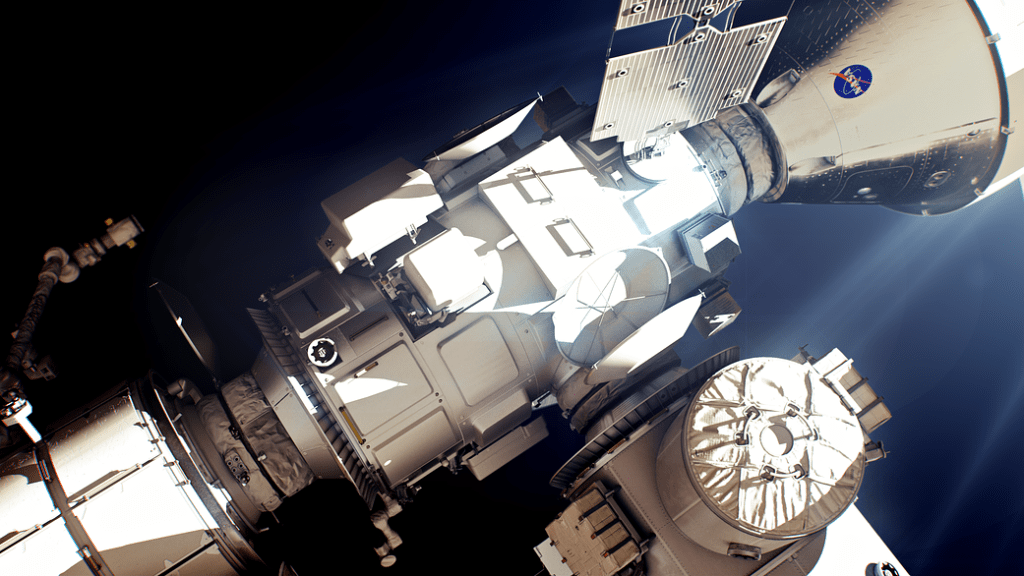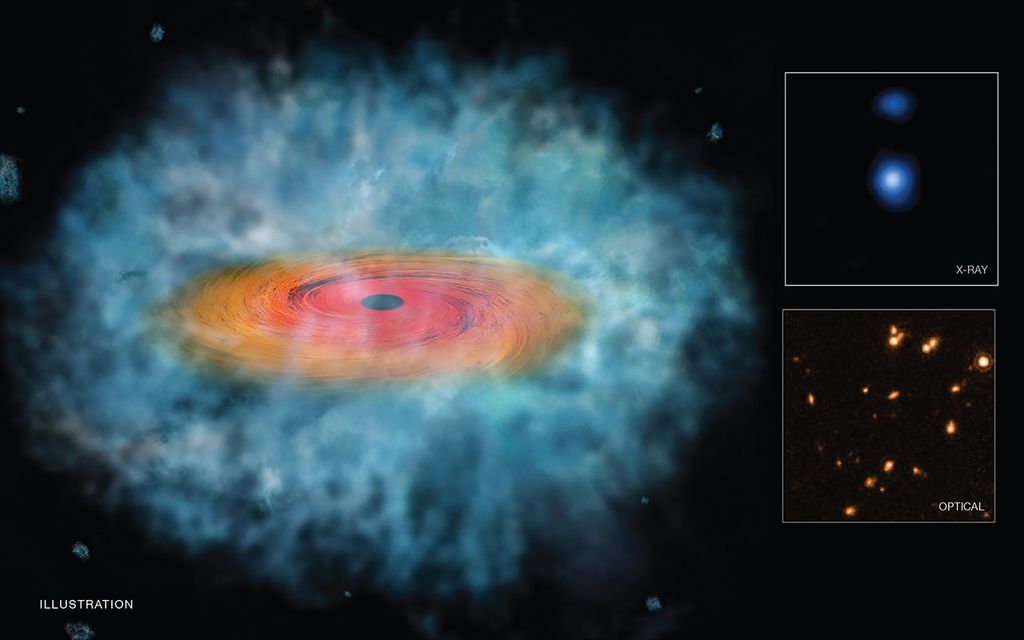
Audience
Educators, Students
Grade Levels
Grades 5-8, Grades 9-12
Subject
Engineering Design, Human Space Exploration, Physical Science, Space Science, Gravity, Missions to Planets and Moons
Type
Hands-on Activities, Lesson Plans / Activities
Introduction
As NASA sets its sights on returning to the Moon and preparing to travel to Mars, it is laying the foundation for human exploration deeper into the solar system by creating a Moon-orbiting outpost called Gateway.
Construction has already begun on Gateway. U.S. companies and international partners will design, build, and launch all the independent elements that join in lunar orbit to create the space station. These elements include living spaces, electrical components, advanced robotics, docking ports, and science equipment.
The initial two elements, the Power and Propulsion Element and the Habitation and Logistics Outpost (HALO), are scheduled to launch together on a private rocket and reach lunar orbit no earlier than 2027 as part of the Artemis IV mission. The Power and Propulsion Element will provide maneuverability and 60 kilowatts of solar electric power to Gateway. HALO will provide living quarters, life support systems, and docking ports for visiting spacecraft and future modules that will expand the space station. After the Power and Propulsion Element and HALO reach lunar orbit, NASA will test-drive their power, communications, and life support systems.
After testing is complete, NASA will launch an additional habitation element, Lunar I-Hab, to Gateway as part of the Artemis IV mission. During this mission, astronauts will enter Gateway for the first time. Some of the crew members will use a docked Human Landing System to travel to the lunar surface.
Subsequently, additional Artemis missions will enhance Gateway by adding more elements, increasing its capabilities for science and exploration. These elements include:
- Lunar View — a habitable element that will provide cargo and fuel storage as well as views of the Moon and space through its windows.
- Crew and Science Airlock — allow crew and science payloads to transfer to and from Gateway and the vacuum of space to perform spacewalks.
- Logistics Module —cargo module that will contain science experiments and supplies needed aboard Gateway.
- Canadarm3 — a multi-jointed articulated robotic system on the exterior of Gateway that will help maintain and repair the space station, assist astronauts during spacewalks, and capture and maneuver visiting spacecraft.
In this activity, students will work as a team to design and build a model of a space habitat with multiple modules, like
those that will form Gateway. They will then test its structural integrity, make careful observations, and collect data for
analysis, mirroring the rigorous process used by the Gateway team at NASA.
![]() Grade Range: 6-12
Grade Range: 6-12
![]() Time Needed: 90-120 Minutes
Time Needed: 90-120 Minutes
![]() Materials List
Materials List
Ensure that students have:
-
- Meterstick
- Paper/Pencil for brainstorming
- Scissors
- Stapler
- Tape
- White glue
- Building materials (e.g., aluminum foil, balloons, skewers, bubble wrap, buttons, cardboard, paper bags, pipe cleaners, plastic bottles or cups, popsicle sticks, straws, etc.)
![]() Safety
Safety
Ensure students are practicing safe handling techniques when using scissors. If using glue guns, make sure the glue gun station is always monitored.
Activity Procedure
Preparation
- Gather and prepare all supplies listed on the materials list.
- If using a glue gun, even cool-melt glue, set up a glue gun station for safety and supervision.
- If presenting videos or web-based resources, test the links and the classroom technology ahead of time.
- Divide the class into teams of three to four students.
- Provide context for this activity using the Background information in this activity. Discuss the different types of modules in a space habitat and the types of forces they might experience during launch and assembly.
- Explain the details of the challenge, including the design constraints and your expectations for teamwork and classroom management.
Design Constraints
The space habitat must contain the following five modules:
- Power and propulsion module with solar panels and thrusters.
- Habitation module with an exterior docking port.
- Laboratory module with an exterior docking port.
- Storage module with two exterior docking ports.
- Airlock module with an external hatch.
In addition to the five modules, you must attach the following to the outside of the spacecraft:
- Robotic arm to assist in construction and docking.
- Communications array for contacting Earth, a ground station, or other spaceships.
- Instrument package to study a nearby planet or moon.
Testing Requirements
- Drop test: To ensure that the five modules can withstand the stress of launching into space, each one must “survive” a drop test with no structural damage from a height of 1 m to be certified for assembly and installation to the space habitat. If any components break or fall off, teams must improve the design and test again.
- Volume constraint: To ensure that the space habitat does not exceed the volume constraint, the entire space habitat cannot be more than 1 m high, 1 m long, or 1 m wide.
- Structural strength test: To ensure that the space habitat will stay together in orbit, the completed model must undergo a structural strength test. Once it has been assembled, a team member must be able to hold it with one hand without any modules or other pieces falling off.
Challenge Questions
- What challenges did your team face when completing this activity?
- After completing the activity, what would you change about your original design?
- What types of challenges do you think engineers are facing while designing and building components of a
space habitat for NASA?
Extensions
- Challenge students to use leftover materials to create a spacecraft and landing vehicles that can dock with their space habitat.
- Add a cost constraint to the challenge and create a budget for students to “purchase” materials. Assign cost to all materials based on mass, area, or type of material.
Career Connection
Building Gateway, our upcoming lunar-orbiting outpost, requires a team of people with diverse expertise and specialized skills working together. Below are just a few examples.
Advanced Manufacturing Technicians use cutting-edge tools and technology — like robotics, 3D printing, and computer-aided design — to build high-performance parts for aerospace systems. They help turn innovative designs into precise, reliable components for space missions.
The CNC (Computer Numerical Control) Machinist Technicians are essential to fabricating the precision parts used in NASA’s Gateway. They operate advanced, computer-controlled machines to manufacture highly accurate metal and composite components that meet NASA’s standards, and by interpreting engineering drawings, CAD files, programming CNC machines, working with aerospace materials, and using precision tools to perform quality checks, they support the development and assembly of Gateway modules.
Materials Scientist / Materials Engineer selects the right materials for space habitats is crucial. These experts research, develop, and test advanced materials — like lightweight composites and radiation-shielding alloys — that can withstand the harsh conditions of space. They ensure materials are strong, durable, and fit for long-duration missions.
Astrobiologists study how living organisms can survive and adapt in space environments. They research the effects of microgravity, radiation, and other space conditions on human health and other life forms. Their work helps design habitats that support life safely during long-duration space missions.
Download Activity
Explore Related Activities
Habitation with Gateway: Assessing Structural Integrity Activity





























